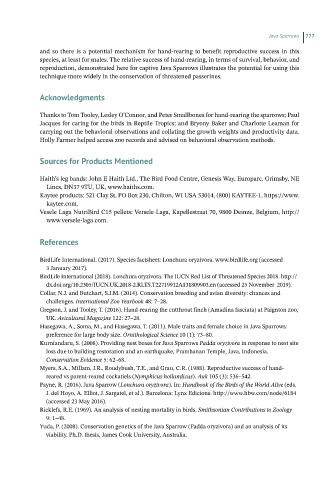Page 774 - Hand rearing birds second
P. 774
Java Sparrows 777
and so there is a potential mechanism for hand‐rearing to benefit reproductive success in this
species, at least for males. The relative success of hand‐rearing, in terms of survival, behavior, and
reproduction, demonstrated here for captive Java Sparrows illustrates the potential for using this
technique more widely in the conservation of threatened passerines.
Acknowledgments
Thanks to Tom Tooley, Lesley O’Connor, and Peter Smallbones for hand‐rearing the sparrows; Paul
Jacques for caring for the birds in Reptile Tropics; and Bryony Baker and Charlotte Leaman for
carrying out the behavioral observations and collating the growth weights and productivity data.
Holly Farmer helped access zoo records and advised on behavioral observation methods.
Sourcesfor ProductsMentioned
Haith’s leg bands: John E Haith Ltd., The Bird Food Centre, Genesis Way, Europarc, Grimsby, NE
Lincs, DN37 9TU, UK, www.haiths.com.
Kaytee products: 521 Clay St, PO Box 230, Chilton, WI USA 53014, (800) KAYTEE‐1, https://www.
kaytee.com.
Vesele Laga NutriBird C15 pellets: Versele‐Laga, Kapellestraat 70, 9800 Deinze, Belgium, http://
www.versele‐laga.com.
References
BirdLife International. (2017). Species factsheet: Lonchura oryzivora. www.birdlife.org (accessed
3 January 2017).
BirdLife International (2018). Lonchura oryzivora. The IUCN Red List of Threatened Species 2018. http://
dx.doi.org/10.2305/IUCN.UK.2018-2.RLTS.T22719912A131809903.en (accessed 25 November 2019).
Collar, N.J. and Butchart, S.J.M. (2014). Conservation breeding and avian diversity: chances and
challenges. International Zoo Yearbook 48: 7–28.
Gregson, J. and Tooley, T. (2016). Hand‐rearing the cutthroat finch (Amadina fasciata) at Paignton zoo,
UK. Avicultural Magazine 122: 27–28.
Hasegawa, A., Soma, M., and Hasegawa, T. (2011). Male traits and female choice in Java Sparrows:
preference for large body size. Ornithological Science 10 (1): 73–80.
Kurniandaru, S. (2008). Providing nest boxes for Java Sparrows Padda oryzivora in response to nest site
loss due to building restoration and an earthquake, Prambanan Temple, Java, Indonesia.
Conservation Evidence 5: 62–68.
Myers, S.A., Millam, J.R., Roudybush, T.E., and Grau, C.R. (1988). Reproductive success of hand‐
reared vs parent‐reared cockatiels (Nymphicus hollandicus). Auk 105 (3): 536–542.
Payne, R. (2016). Java Sparrow (Lonchura oryzivora). In: Handbook of the Birds of the World Alive (eds.
J. del Hoyo, A. Elliot, J. Sargatel, et al.). Barcelona: Lynx Edicions. http://www.hbw.com/node/6184
(accessed 23 May 2016).
Ricklefs, R.E. (1969). An analysis of nesting mortality in birds. Smithsonian Contributions to Zoology
9: 1–48.
Yuda, P. (2008). Conservation genetics of the Java Sparrow (Padda oryzivora) and an analysis of its
viability. Ph.D. thesis, James Cook University, Australia.

